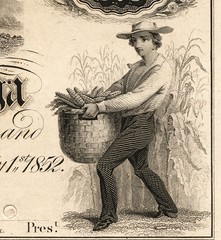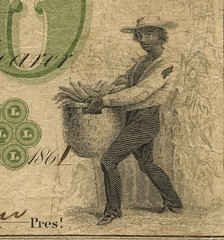
PREV ARTICLE
NEXT ARTICLE
FULL ISSUE
PREV FULL ISSUE
BOOK REVIEW: PICTURES FROM A DISTANT COUNTRY
From the author's Introduction: Jacob Perkins revolutionized the creation of money. The processes that he developed worked so perfectly that they remained the basis of security printing for more than a century and a half. At the heart of Perkins’s processes was the belief that all currency should be and would be identical. Only in that way, he reasoned, would the public have an absolute assurance about which note was good and which bad. The designs he devised were therefore lacking in artistry, but infernally difficult to counterfeit. He set up a security-printing establishment in Newburyport, Massachusetts, and a grateful legislature gave him a monopoly on all note-printing there and in Maine (which formed part of Massachusetts until 1820). Soon Perkins’s homely-but-distinctive products were appearing across New England and well beyond. But the inventor had unleashed far more than he had anticipated. He had assumed that all bankers would flock to his processes and designs. He was right on the first count but wrong on the second. His techniques had become common knowledge within a decade or so of their invention, and everyone agreed that they were the final word in security printing. But agreement ended there: what the bankers wanted (and what a succeeding generation of printers found it expedient to give them) was variety: far from the universality which Perkins foresaw, the bankers envisioned a broad choice of pictorial design, a host of renditions whose artistry and excellence would distinguish their notes from those of their competitors. Perkins’s successors, beginning with Murray, Draper, Fairman & Company and ending with the American Bank Note Company, would find that they could give their customers what they wanted, using transfer technology. By the mid-1830s, the process was in full swing: the American private bank note was approaching its maturity, and those who created it and those who commissioned it were finding an important new use for their product, beyond the mere buying and selling of goods. They were finding it useful for telling the country about itself, about where it had been, where it was going, and who was along for the ride. What they found (and what we can learn from them) will form the remainder of this book. I guess I'd never fully understood why Perkins' plan for currency never took off. The designs were secure, but they were bland. Who wants bland when you can have some color and variety? Together with the explosion of banks and banknotes due to the laws and economy of the day, obsolete banknotes proliferated in an abundance of issuers, styles, designs, and denominations. This beautifully illustrated coffee-table style book is a wonderful introduction and overview of the series, but it's far from lightweight - as shown with the Perkins discussion, even a more seasoned numismatist like me can learn something from Doty's insights. Despite the pretty pictures, this is no numismatic Playboy issue - you'll want to devour the text as well. Doty covers many aspects of the imagery often seen in the notes. Here's a passage about the relationship of Liberty and founding father George Washington.
Among these worthies, no one was more important than George Washington, victorious general, first president, father of the nation. Washington often appeared with Liberty (and with other allegorical figures, as we shall shortly see). But one of the most striking depictions appeared fairly early, and it came from the frontier Northwest. In 1838, a Michigan banker in the hamlet of Saline asked his printer in New York to pull out all the stops. The result was a skillful, if crowded, image of the hero, flanked and sustained by Liberty (whose pole and pileus actually bisect the portrait). Flags and the national shield complete the arrangement While most of the illustrations are close-ups of the notes, for reference ALL of the notes illustrated are all shown full size in an appendix which comprises about half of thebook. Here's a note from Winchester, VA:

Getting back to Doty's insights and commentary, here's another great example, dealing with how certain images were retouched and reused on different notes. In our second case, the retouching was even less radical. In 1852, the Farmers Bank of Onondaga came into existence, enjoyed a brief and troubled career, and failed the following year. But it ordered currency in several denominations from a New York firm called Wellstood, Hanks, Hay & Whiting, and it placed some of it in circulation prior to its demise. For its $1 bill, printer and banker agreed upon a vignette of a young white farmhand carrying a basket of corn. A few years later, another banker wanted new paper money. This banker was Southern, and he wanted a slave scene. Wellstood, Hanks, Hay & Whiting (who by now formed part of a new firm, the American Bank Note Company), could easily oblige. They took their white farmhand, blackened his skin, tattered his clothing, and added a patch to his shirt—and he now did duty as a slave in Virginia. This is all quite amusing to us, but it was serious business to the people of the time. For if the country had become so divided that its security printers were required to supply two sets of images, one for each section, matters were passing beyond mortal control.


The book fails my back-of-the-book test - there is no bibliography or index, although there is a listing of the pictured notes by state and town. As a bibliophile though, I do appreciate the wonderful full-color dust jacket. I'll probably protect this one with a Brodart cover if I have one in that size. When I finish reading it I'll prepare a place of honor for it on my shelf of literature on U.S. obsolete paper money. It's a great companion to the Roger Durand series of "Notes on..." portraits, vignettes, denominations and allegorical representations on obsolete notes. (Which points out why a great book ought to have a bibliography or at least a "Further Reading" section - to point the readers to related books for further investigation). I'd recommend the book to any numismatist, whether you collect obsolete paper money or not. And to any student of U.S. history. For more information and ordering information, see the earlier E-Sylum article. Publisher Dennis Tucker adds: The Wall Street Journal featured the book in its April 13, 2013, edition. It’s good to see this hugely important area of American financial history --- 70 years of paper currency issued by thousands of banks and other entities --- getting national recognition in the mainstream media.
To read the earlier E-Sylum article, see:
NEW BOOK: PICTURES FROM A DISTANT COUNTRY
(www.coinbooks.org/esylum_v16n12a03.html)
The Numismatic Bibliomania Society is a non-profit organization promoting numismatic literature. See our web site at coinbooks.org. To submit items for publication in The E-Sylum, write to the Editor at this address: whomren@gmail.com To subscribe go to: https://my.binhost.com/lists/listinfo/esylum All Rights Reserved. NBS Home Page Contact the NBS webmaster 
|

